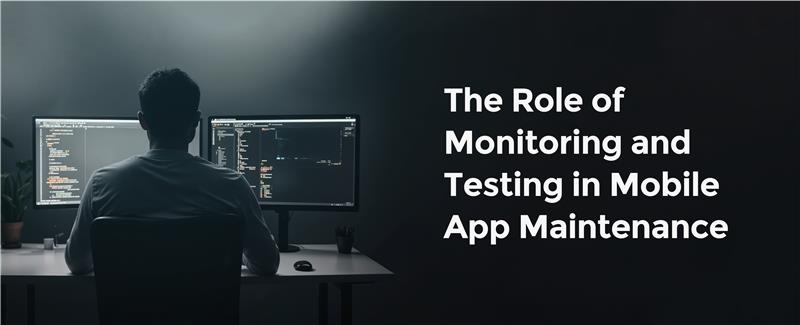The Role of Monitoring and Testing in Mobile App Maintenance
5 Apr 25 


Key Takeaways:
- Effective monitoring reveals critical performance issues before they impact most users
- Regular testing across device types prevents compatibility disasters with each update
- Combining both creates a feedback loop that extends app lifespan and maintains user satisfaction
- Automated testing reduces maintenance costs while improving reliability
Did you know that 88% of users are less likely to return to an app after experiencing performance issues, yet the average mobile app loses 77% of its daily active users within the first three days after installation? In the competitive mobile app marketplace, maintaining performance isn’t just about technical excellence—it’s about survival.
Understanding Mobile App Maintenance
Mobile app maintenance encompasses the ongoing processes that keep applications relevant, functional, and secure after initial deployment. It includes fixing bugs, updating features, improving performance, and ensuring compatibility with new device models and operating system versions.
Unlike traditional software, mobile apps operate in a highly fragmented environment. Different screen sizes, OS versions, hardware capabilities, and user behaviors create countless variables that impact performance. This complexity makes consistent monitoring and thorough testing absolutely essential for long-term success.
The Critical Role of Monitoring
Real-time Performance Insights
App monitoring tools provide developers with real-time data about how applications perform in the wild. This isn’t just about catching crashes – though that’s certainly important. It’s about understanding load times, memory usage, battery consumption, and other factors that might not cause immediate failures but can gradually erode user satisfaction.
A well-known travel app once received complaints about battery drain despite passing all pre-release tests. Only through proper monitoring did the development team identify a background process that was unnecessarily active, silently killing users’ batteries throughout the day.
User Behavior Analysis
Monitoring isn’t limited to technical performance metrics. Modern monitoring solutions capture valuable data about user behavior – which features get used most frequently, where users spend their time, and at which points they tend to abandon processes.
This behavioral data proves invaluable for maintenance decisions. For example, if monitoring reveals that users rarely access a particular feature that consumes significant development resources to maintain, development teams might consider removing or simplifying it in future updates.
Proactive Problem Detection
The best kind of problem is the one fixed before users notice it. Effective monitoring allows development teams to identify potential issues before they impact the majority of users.
For instance, monitoring might reveal that a specific device model experiences higher crash rates, or that performance degrades after users store a certain amount of data. Addressing these edge cases quickly prevents them from becoming widespread problems that damage an app’s reputation.
Also read A Complete Guide To Mobile App Testing: Types And Benefits
Testing: Ensuring Quality Through Every Update
Regression Testing
One of the most common maintenance challenges is the “fix one thing, break another” phenomenon. Even small changes to an app’s codebase can have unexpected consequences on seemingly unrelated features.
Regression testing – verifying that previously developed features still work after changes – is essential to prevent this. While it might seem tedious to repeatedly test existing functionality, the alternative is far worse: users discovering that their favorite feature suddenly stopped working after an update.
Compatibility Testing
The mobile ecosystem constantly evolves, with new device models and OS versions regularly entering the market. Each new combination presents potential compatibility issues.
Many perfectly functional apps suddenly fail when a new Android or iOS version rolls out, simply because developers didn’t test against beta versions of the operating systems. Regular compatibility testing across different devices and OS versions helps ensure apps continue working for all users.
Performance Testing
Users have increasingly high expectations for app performance. Slow load times, laggy interfaces, or excessive resource consumption can drive users away just as surely as outright crashes.
Performance testing under various conditions – different network speeds, device states, and usage patterns – helps identify optimization opportunities before performance issues impact the user base.
Integrating Monitoring and Testing for Maximum Effectiveness
The real power comes when monitoring and testing work together in a continuous feedback loop:
- Monitoring identifies potential issues in the real world
- These insights inform targeted testing scenarios
- Testing validates the fixes or improvements
- Monitoring confirms the effectiveness of changes after deployment
This cyclical process ensures that maintenance efforts focus on actual user needs rather than theoretical problems.
Practical Implementation Strategies
Start with the Right Tools
Implementing effective monitoring and testing begins with selecting appropriate tools. For monitoring, solutions like Firebase Performance Monitoring, New Relic, or AppDynamics provide comprehensive insights. For testing, frameworks like Appium, XCTest, or Espresso enable automated testing across different scenarios.
The right combination depends on specific app requirements and development stack. What matters most is having tools that integrate well with existing workflows.
Automate Wherever Possible
Manual testing has its place, particularly for evaluating subjective aspects like UI design. However, automating routine tests dramatically improves maintenance efficiency.
Automated tests can run nightly, checking core functionality across multiple device configurations without tying up development teams. This continuous testing helps catch issues quickly before they reach users.
Prioritize Based on User Impact
Not all bugs or performance issues deserve equal attention. The art of effective maintenance lies in prioritizing issues based on their actual impact on users.
Monitoring data proves invaluable here, helping teams distinguish between theoretically concerning but practically harmless issues and the problems that actively frustrate users. This approach ensures maintenance resources focus on changes that deliver the greatest user benefit.
Also read How Does User Feedback Impact Mobile App Maintenance?
The Human Element
Despite all the technical tools available, successful mobile app maintenance still requires human judgment. Data from monitoring tools needs interpretation, testing results need evaluation, and decisions about what to fix first require balancing technical and business considerations.
Experienced developers know that some patterns in the data might indicate serious underlying problems while others represent expected variations. This judgment comes from experience and deep understanding of both the technical architecture and the app’s purpose.
Final Thoughts
In the competitive world of mobile apps, launching is just the beginning. Long-term success depends on maintaining apps through continuous monitoring and testing. These complementary processes provide the insights and quality assurance needed to keep apps relevant, functional, and valuable to users.
The most successful apps aren’t necessarily those with the most features or flashiest designs – they’re the ones that consistently work as expected, adapt to changing conditions, and maintain high performance standards over time. Effective monitoring and testing make this possible by providing both the visibility and verification needed for smart maintenance decisions.
Ready to Elevate Your App’s Performance?
At Mindster, our experienced team implements robust monitoring and testing protocols that extend your app’s lifespan and maximize user satisfaction. Whether launching a new application or improving an existing one, proper maintenance strategies can dramatically impact your app’s success. Contact Mindster today to discover how our maintenance expertise can help your mobile application to stand out in today’s competitive marketplace.
- Agentic AI1
- Android Development3
- Artificial Intelligence35
- Classified App3
- Custom App Development5
- Digital Transformation12
- Doctor Appointment Booking App14
- Dropshipping1
- Ecommerce Apps40
- Education Apps2
- Fintech-Apps37
- Fitness App4
- Flutter4
- Flutter Apps20
- Food Delivery App5
- Grocery App Development1
- Grocery Apps3
- Health Care10
- IoT2
- Loyalty Programs9
- Matrimony Apps1
- Microsoft1
- Mobile App Maintenance2
- Mobile Apps130
- Product Engineering6
- Progressive Web Apps1
- React Native Apps2
- Saas Application2
- Shopify9
- Software Development3
- Taxi Booking Apps7
- Truck Booking App5
- UI UX Design8
- Uncategorized6
- Web App Development1



















Comments